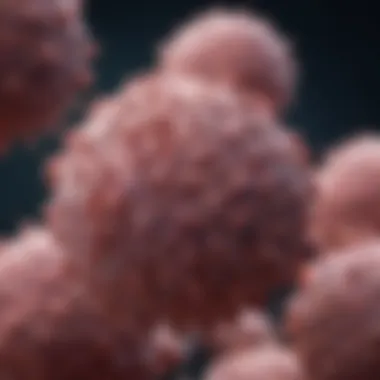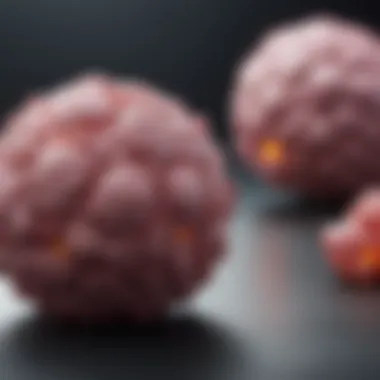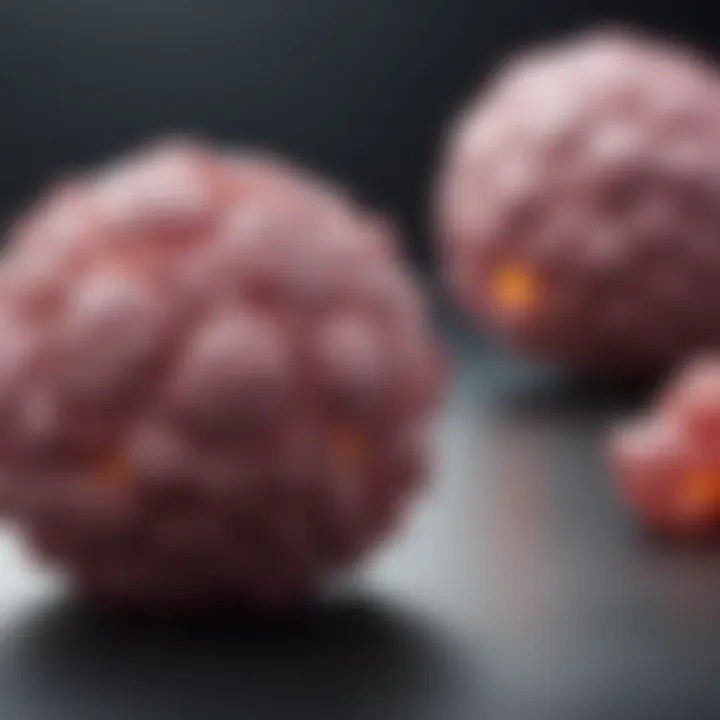Understanding Solid Tumours: Types and Implications


Overview of Research Topic
Solid tumours are a critical area of study within the field of oncology. They encompass a wide variety of neoplasms that arise from different types of tissues or organs. From breast cancer to colorectal cancer, these tumours present unique characteristics that inform their diagnosis and treatment strategies. Understanding these specificities is paramount for anyone involved in medical science, whether in education, research, or clinical practice.
Brief Background and Context
The development of solid tumours involves a series of complex biological processes, including gene mutations, environmental influences, and cellular interactions. Each type of solid tumour has distinct histopathological traits. These traits impact how tumours grow, metastasize, and respond to treatments. Examining solid tumours requires a multidisciplinary approach, integrating methods from molecular biology, pharmacology, and clinical practice.
Importance in Current Scientific Landscape
In recent years, there has been a surge in research focused on solid tumours. Innovations in diagnostic techniques, such as advanced imaging and molecular assays, have enhanced clinicians' ability to detect and determine the stages of these tumours early. Additionally, targeted therapies and immunotherapies have emerged, offering new avenues for treatment. Understanding solid tumours is thus essential, as it directly relates to improving patient outcomes and advancing cancer treatment strategies.
Methodology
Research Design and Approach
The methodologies employed in studying solid tumours can vary greatly depending on the specific cancer type and research objectives. Researchers typically employ a combination of retrospective and prospective studies. This allows for a comprehensive analysis of tumour biology and its clinical implications. Data collected helps inform future studies and treatment protocols.
Data Collection Techniques
When researching solid tumours, various data collection techniques are used. Common approaches include:
- Histological analysis: Examining tissue samples under a microscope to understand the tumour's characteristics.
- Immunohistochemistry: Utilizing antibodies to detect specific proteins in tissue samples. This aids in identifying tumour types and potential treatment targets.
- Genomic profiling: Analyzing genetic material from tumours to identify mutations and alterations that may influence treatment strategies.
Engaging in these methodologies provides a strong foundation for advancing knowledge in the field of oncology.
"Solid tumours represent complex entities requiring innovative study approaches to drive advances in treatment and care."
Prolusion to Solid Tumours
The study of solid tumours is crucial in the field of oncology because tumours can significantly impact human health. Solid tumours emerge from a variety of tissues or organs and present unique characteristics and challenges in terms of their diagnosis and treatment. Understanding solid tumours involves recognizing their biological behaviour, how they interact with surrounding tissues, and the implications for patient care.
One important aspect of this topic is the classification of tumours. Solid tumours can be benign or malignant, with malignant tumours posing a higher risk to the patient due to their ability to invade nearby tissue and metastasize. By comprehending these classifications, medical professionals can better devise treatment strategies tailored to individual cases.
Moreover, solid tumours have a rich array of characteristics, including their cellular composition, growth patterns, and the specific microenvironments they inhabit. These characteristics further elucidate how tumours develop and proliferate, which is essential for developing effective therapies.
The implications of solid tumours extend beyond the laboratory and hospitals. They affect healthcare systems, influence research directions, and have significant social and economic impacts. Therefore, a comprehensive understanding of solid tumours is fundamental not only for practitioners and researchers but also for patients who seek informed choices about their health.
"Understanding solid tumours equips researchers and healthcare providers with the necessary tools to improve treatment strategies and patient outcomes."
Through this article, we will delve into the definitions, characteristics, types, and implications of solid tumours, strengthening the knowledge base required to face challenges in oncology.
Defining Solid Tumours
Solid tumours are abnormal masses of tissue that originate from various types of cells within organs or other solid structures in the body. They can arise from epithelial, mesenchymal, or neuroectodermal cells, among others. These tumours may form within any part of the body and can range from small, localized lesions to large invasive growths.
Typically, solid tumours are classified into two primary categories: benign and malignant. Benign tumours usually do not spread to surrounding tissues or distant organs. They often grow slowly and may be removed surgically without causing significant harm. Malignant tumours, however, exhibit aggressive characteristics, infiltrating local tissues and possessing the capacity to metastasize, which can lead to secondary tumours in different body regions.
Understanding the definition of solid tumours is essential, as it lays the groundwork for clinicians and researchers to gather necessary information for diagnosis and treatment.
Contrast with Liquid Tumours
Solid tumours differ fundamentally from liquid tumours, such as leukemias, which consist mainly of abnormal blood cells circulating in the bloodstream. Unlike solid tumours that form discrete masses, liquid tumours do not occupy physical space in the same manner. Each of these types of tumours affects the body in distinctive ways and necessitates different approaches to treatment.
Liquid tumours involve systemic implications, often requiring therapies that target the entire body, since they disperse through the circulatory system. In contrast, treatment for solid tumours often involves localized interventions, such as surgery or targeted radiation therapy, along with systemic therapies like chemotherapy for advanced cases.
Recognizing the differences between these tumour types is imperative for effective diagnosis and treatment planning. Without a clear understanding of how solid tumours function compared to liquid tumours, healthcare providers may struggle to devise appropriate therapeutic protocols for their patients.
Characteristics of Solid Tumours
Understanding the characteristics of solid tumours is essential for multiple reasons. First, the varied biological behaviours of solid tumours influence diagnosis, treatment, and prognosis. This section delves into three main aspects that define solid tumours: cellular composition, growth patterns, and the tumour microenvironment. Each of these factors plays a critical role in how these neoplasms manifest and respond to therapy.
Cellular Composition
The cellular makeup of solid tumours is diverse and complex, encompassing both tumour cells and supportive stromal cells. Tumour cells themselves can exhibit significant heterogeneity, which is a hallmark of solid tumours. This variation can affect how aggressive the tumour is and how it responds to treatment. Common types of cells found in solid tumours include epithelial cells, mesenchymal cells, and immune cells.
- Epithelial Cells: These are often the primary cell type in solid tumours, particularly in carcinomas.
- Mesenchymal Cells: These cells support structural integrity and can promote tumour growth through various signalling pathways.
- Immune Cells: The presence of immune cells within the tumour microenvironment can either support tumour growth or induce an immune response against it.
This complexity poses challenges for treatment strategies. A better understanding of the cellular composition aids in developing targeted therapies that can address the unique characteristics of tumour cells.


Growth Patterns
The growth of solid tumours can differ markedly. They may grow in a disorganized manner, leading to what is known as local invasion. This type of growth can disrupt surrounding tissues and impair function. For instance, gliomas, which arise from glial cells in the nervous system, infiltrate local brain tissues, making surgical removal challenging.
Alternatively, some tumours can grow in a more organized fashion, pushing aside normal cells rather than invading directly. Understanding these patterns is crucial for effective treatment planning. Here are some key growth patterns:
- Infiltrative Growth: This is common in aggressive cancers and leads to poor surgical outcomes.
- Expansive Growth: This growth pattern is generally associated with benign tumours or slow-growing malignancies.
By recognizing these patterns, clinicians can make better predictions about tumour behaviour and possibly implement appropriate interventions early.
Tumour Microenvironment
The tumour microenvironment is equally important in understanding solid tumours. This environment includes the extracellular matrix, adjacent cells, and various signalling molecules. The interactions between tumour cells and their microenvironment can significantly influence tumour growth and spread.
Factors in the microenvironment can promote angiogenesis, the process of new blood vessel formation, which provides essential nutrients to the tumour. Moreover, immune cells operating within this space can either inhibit or encourage tumour progression, depending on the context.
A deeper investigation into the tumour microenvironment is essential for the development of immunotherapies, which harness the body’s immune system to combat cancer. The understanding of these interactions can shape future treatment strategies.
"The interaction between solid tumours and their microenvironment is crucial in determining their behaviour and therapy response."
Types of Solid Tumours
Understanding the types of solid tumours is fundamental in oncology. Each type has distinctive characteristics and implications for diagnosis, treatment, and prognosis. This section provides a nuanced view of benign and malignant tumours, emphasizing their differences and similarities. Recognizing these types helps in forming appropriate clinical responses and can significantly influence patient outcomes. Knowing these distinctions is crucial not only for healthcare professionals but also for students and researchers involved in oncology studies.
Benign Tumours
Characteristics
Benign tumours are non-cancerous growths that typically do not infiltrate nearby tissues or metastasize to other parts of the body. One key characteristic of benign tumours is their well-circumscribed nature. This means they have distinct borders, which makes them easier to remove surgically. They usually grow slowly and often do not recur after removal, reducing the complexity in treatment compared to malignant tumours. Their low risk of life-threatening complications makes them generally a much less alarming diagnosis. Understanding these characteristics contributes to managing patients effectively and alleviating potential concerns.
Common Types
Among the common types of benign tumours, lipomas and fibromas appear frequently. Lipomas are soft tissue tumours composed of fat cells, while fibromas consist of fibrous or connective tissue. Both are usually asymptomatic and often found incidentally during imaging or physical exams. A key feature of these tumours is their benign behavior; they rarely pose serious health risks. This aspect makes them easier to monitor without immediate intervention, although surgical removal may be considered based on the patient’s preferences or symptoms.
Malignant Tumours
Characteristics
Malignant tumours, unlike benign ones, possess the capacity to invade surrounding tissues and organs. They are characterized by uncontrolled cell growth and cell structure abnormalities, which contribute to aggressive behaviour. The heterogeneity within malignant tumours can also complicate treatment strategies. Understanding these characteristics is essential for determining the appropriate intervention. These tumours often require a multi-faceted treatment approach due to their invasive nature, presenting significant challenges for both clinicians and patients.
Common Types
There are several common types of malignant tumours, including carcinomas and sarcomas. Carcinomas arise from epithelial cells, while sarcomas originate from connective tissues. Each type has its unique features and implications. For example, lung carcinoma is known for rapid progression and metastasis. This poses a more considerable risk to survival and necessitates early detection and aggressive treatment. Recognizing the type of malignant tumour helps in tailoring therapy and improving clinical outcomes.
Staging and Grading
Staging and grading describe the extent of cancer spread and its aggressiveness. Staging is typically determined by the TNM system, which evaluates Tumour size, Node involvement, and Metastasis. Grading is based on how abnormal the cancer cells appear under a microscope. A key characteristic of staging is that it helps clinicians determine the prognosis and treatment options available. Accurate staging ensures effective treatment planning and follow-up strategies, which are essential for patient management. Understanding both aspects is indispensable in the fight against malignant tumours.
Origins of Solid Tumours
The origins of solid tumours are critical to understanding their behavior, characteristics, and treatment approaches. Solid tumours arise from the abnormal growth of cells in specific tissues or organs. Thus, knowing their origins helps in classifying them, which is essential for both diagnosis and treatment planning. The cellular lineage plays a role in how these tumours respond to therapies. For instance, tumours originating from epithelial cells often behave differently from those arising in mesenchymal or neuroectodermal tissues.
Understanding the origins allows researchers and clinicians to identify potential risk factors, genetic predispositions, and even preventive measures that could influence patient outcomes. Moreover, this knowledge aids in the development of targeted therapies, which can be designed specifically for the type of origin a tumour has.
Epithelial Tumours
Epithelial tumours are derived from epithelial cells, which line the surfaces of organs and structures in the body. They are among the most common types of solid tumours and can be classified further into various subtypes based on their histological characteristics.
Characteristics:
- They can be benign or malignant.
- Malignant epithelial tumours include squamous cell carcinoma, adenocarcinoma, and transitional cell carcinoma.
- These tumours typically demonstrate an irregular growth pattern and may invade surrounding tissues.
Common Types:
- Carcinomas: This group includes tumours that originate from glandular tissues and surfaces, like breast and prostate cancer.
- Squamous Cell Carcinoma: Often found in skin, lungs, and cervix, linked to sun exposure and smoking.
Epithelial tumours may also show differing responses to treatments, such as chemotherapy and radiation therapy. This makes understanding their origin key for an effective treatment plan.
Mesenchymal Tumours
Mesenchymal tumours arise from connective tissues like fat, muscle, nerves, and blood vessels. They are less common than epithelial tumours but can be quite aggressive in nature.


Characteristics:
- Generally, these are soft tissue sarcomas and vary in histological appearance.
- They may express unique markers that distinguish them from other tumours.
Common Types:
- Liposarcoma: Originates from adipose tissue.
- Rhabdomyosarcoma: Often seen in children, arises from skeletal muscle.
Understanding the behaviour and characteristics of mesenchymal tumours can guide treatment decisions, which may include surgical removal and targeted therapies.
Neuroectodermal Tumours
Neuroectodermal tumours arise from neural tissue. These tumours can be particularly complex due to their neurological implications.
Characteristics:
- They may have distinct patterns of growth.
- Commonly malignant, and they often require specialized neurological expertise for effective management.
Common Types:
- Neuroblastoma: Typically occurs in children, arising from immature nerve cells.
- Medulloblastoma: Found in the cerebellum, commonly diagnosed in pediatric patients.
These tumours can present unique challenges in both diagnosis and treatment due to their location and potential impact on critical brain functions. Hence, understanding their origin is crucial for developing appropriate therapeutic strategies.
"The tissue of origin fundamentally influences treatment strategies for solid tumours."
In summary, the origins of solid tumours play a significant role in not only their classification but also in their management and treatment. Recognizing the types—epithelial, mesenchymal, and neuroectodermal—provides insights that can shape future research and therapeutic advancements in oncology.
Diagnosis of Solid Tumours
The diagnosis of solid tumours is a critical aspect of cancer management. Early and accurate diagnosis is essential for determining the appropriate treatment pathways and ultimately improving patient outcomes. The diagnostic process typically involves a combination of imaging techniques, biopsy methods, and molecular testing. Understanding each component aids healthcare professionals in making informed decisions regarding patient care.
Imaging Techniques
Imaging techniques play a pivotal role in the diagnostic process. They help visualize tumours and understand their size, location, and potential spread to other tissues. The choice of imaging modality may depend on the patient's specific case, the type of tumour suspected, and the reason for investigation.
X-rays
X-rays are one of the first imaging techniques used in identifying solid tumours. They provide a basic overview of bones and some soft tissues. The key characteristic of X-rays is their ability to quickly generate images. This is beneficial for initial assessments, especially in emergency situations. However, X-rays have limitations; they can miss smaller tumours or those located in complex anatomical areas. Thus, while they are popular and widely available, they are often not sufficient for a definitive diagnosis.
CT Scans
Computed tomography (CT) scans offer detailed cross-sectional images of the body, providing greater insight than standard X-rays. CT scans can show the size, shape, and density of masses, making them a commonly used tool in the diagnosis of solid tumours. A unique feature of CT scans is their ability to combine data from multiple angles, creating a comprehensive view of the tumour and its surrounding structures. Nevertheless, the use of ionizing radiation raises concerns about safety, particularly in young patients or those requiring frequent imaging.
MRIs
Magnetic resonance imaging (MRI) is another invaluable imaging technique. It uses strong magnets and radio waves to generate detailed images of soft tissues, which is particularly useful in identifying solid tumours in the brain, spinal cord, and pelvis. One of the main advantages of MRI is its high contrast resolution, allowing for the differentiation between various types of soft tissue. Despite its benefits, MRI is more time-consuming and expensive than other imaging modalities. Additionally, patients with certain implants or devices may not be able to undergo MRI scans.
Biopsy Methods
Biopsies are essential to confirm a diagnosis of solid tumours. Obtaining tissue samples allows for histological examination, which is critical for determining the nature of the tumour and informing treatment plans. Two primary biopsy methods are common in clinical practice.
Needle Biopsy
Needle biopsies involve using a thin needle to extract tissue from a suspicious mass. This method is minimally invasive and often performed under local anesthesia, making it a patient-friendly choice. The key characteristic of needle biopsy is its efficiency, as it can provide rapid results compared to more invasive procedures. However, one limitation is that it may not retrieve sufficient tissue for all types of tumours, which can hinder diagnosis or further testing.
Surgical Biopsy
Surgical biopsies are more invasive procedures that involve removing a larger portion of the tumour or the entire mass. This method provides a definitive diagnosis and allows for a more comprehensive analysis of the tumour. The unique feature of surgical biopsy is the ability to obtain large samples, which is particularly useful for complex cases. However, the risks associated with surgery, such as infection or complications, must be carefully considered, making this option less favorable in certain situations.
Molecular Testing
Molecular testing has emerged as an essential tool in the diagnosis of solid tumours. This process examines the genetic material from the tumour to identify specific mutations or markers. It can provide insights into the tumour's behavior and potential response to targeted therapies. As technology advances, molecular testing is becoming increasingly accessible, adding a valuable layer of precision to cancer diagnosis. Understanding the specific molecular characteristics of a tumour can help physicians strategize more effective treatment plans, leading to improved patient outcomes and tailored therapies.
Treatment Options for Solid Tumours
The treatment of solid tumours is a crucial aspect of oncology. A thorough understanding of treatment options can significantly impact patient outcomes and quality of life. Different treatments may target various aspects of the tumour’s biology and its microenvironment, leading to improved efficacy and reduced side effects. Understanding these modalities helps in tailoring the approach for individuals, based on specific tumour characteristics, patient health, and personal preferences.
Surgical Intervention


Surgical intervention is often the primary method for treating solid tumours, particularly when the tumour is localized. The objective is to completely remove the tumour and surrounding tissue. This can lead to a potential cure for some patients. The effectiveness of surgery relies on the staging of the cancer, the tumour's size, and its location.
Surgery can be classified into two types: curative and palliative. Curative surgery aims to remove the entire tumour, hence aiming for a complete cure. Palliative surgery, on the other hand, seeks to relieve symptoms without the goal of curing the disease. Additionally, postoperative care is critical to address complications and to monitor for recurrence.
Radiation Therapy
Radiation therapy employs high doses of radiation to kill cancer cells or shrink tumours. This treatment can be used as a primary treatment, post-surgery to eliminate residual cells, or as palliative care. The method is particularly beneficial for tumours situated where surgery may pose a risk.
Radiation comes in two primary forms: external beam radiation and internal radiation (brachytherapy). The choice depends on various factors, including the type of tumour, its location, and treatment goals. Patients receiving radiation therapy must be monitored for side effects, which may include fatigue, skin irritation, and more severe long-term effects.
Chemotherapy
Chemotherapy utilizes drugs to destroy rapidly dividing cancer cells. It is most effective against tumours that are not confined to a single location and may help to shrink tumours before surgery or eliminate cancer cells post-surgery.
The therapy can cause significant side effects, ranging from nausea to immunosuppression. Hence, it requires careful patient monitoring. New developments have introduced combination therapy where various drugs are used in tandem to increase efficacy while potentially mitigating some side effects.
Targeted Therapies
Targeted therapies represent a promising avenue in treating solid tumours. These therapies focus on specific molecules and pathways associated with cancer growth. For example, medications like trastuzumab are used for tumours that overexpress HER2 receptors.
The specificity of targeted therapies generally leads to fewer side effects compared to conventional chemotherapy. However, they require thorough molecular profiling of tumours to identify potential targets effectively. This precision medicine approach emphasizes the importance of personalized therapy in oncology.
Immunotherapy
Immunotherapy is an innovative treatment that utilizes the body’s immune system to combat cancer. This method can change how the immune system recognizes and fights off tumours. Immune checkpoint inhibitors and CAR T-cell therapies are examples that have shown significant effectiveness in some solid tumours.
While promising, immunotherapy is not universally effective and can lead to immune-related adverse effects. Thus, careful selection of candidates is crucial to optimize outcomes and manage side effects.
Recent Advances in Solid Tumour Research
Research in solid tumours is evolving rapidly, bringing forth innovations that transform how we understand and treat these malignancies. In recent years, the integration of modern technology and scientific discoveries have advanced our comprehension of solid tumours extensively. This section highlights these crucial advancements, particularly in genomics, new biomarkers, and clinical trials. The importance of these developments lies not only in improving existing treatments but also in shaping future therapeutic strategies, thus providing a roadmap for enhanced patient outcomes.
Genomics and Solid Tumours
Genomics has brought a revolutionary perspective to solid tumour research. It involves studying the entirety of an organism’s genetic material. In solid tumours, genomic analysis enables the identification of mutations and alterations that drive cancer growth.
By analyzing oncogenes and tumor suppressor genes, researchers have discovered specific genetic signatures associated with various solid tumours. This information can lead to precision medicine – the customization of treatment based on an individual’s genetic profile. As a result, therapies can be tailored to target these mutations more effectively. Key advancements in methods like whole-genome sequencing, RNA sequencing, and next-generation sequencing facilitate this work, allowing clinicians to provide more personalized treatment plans, thereby increasing the probability of successful outcomes.
New Biomarkers
New biomarkers are essential in the field of oncology as they serve as indicators of tumor presence, progression, and response to therapy. Solid tumours have unique biomarker profiles that researchers are now identifying through advanced technologies.
These biomarkers can be proteins or genetic markers detectable in body fluids or tissues. Incorporating biomarkers into clinical practice enhances diagnostic accuracy and enables better monitoring of treatment efficacy. Some pivotal recent discoveries include blood-based biomarkers that can predict response to therapies such as immunotherapy and targeted therapies. This emerging field is vital, offering the potential for less invasive tests that significantly improve patient experience and outcomes.
"The identification of relevant biomarkers can dramatically change clinical decision-making in solid tumours, leading to timely and effective interventions."
Clinical Trials
Clinical trials remain foundational in advancing the treatment of solid tumours. They provide critical insights into the efficacy and safety of new therapies. Recent advances in trial designs, such as adaptive clinical trials, have gained traction. These designs allow modifications to the trial process based on interim results, optimizing patient outcomes more swiftly.
Moreover, the focus on rare solid tumours is increasing. Many initiatives now strive to involve more diverse patient populations, ensuring broader applicability of findings. One significant trend is the rise of basket trials, which evaluate multiple tumors under various treatment regimens. This approach streamlines research processes and facilitates discoveries that could benefit a wider array of patients.
End
Understanding solid tumours is crucial within the field of oncology. This article provides a structured overview, emphasizing the significance of knowing the characteristics, types, and research advancements related to solid tumours.
The key points discussed throughout the article underscore the complexity of solid tumours. These neoplasms can vary greatly in their biology and behavior, which directly impacts diagnosis and treatment strategies. Recognizing the diverse cellular origins helps improve treatment personalization, and understanding the microenvironment surrounding solid tumours enhances therapeutic approaches.
Here are some specific benefits of studying solid tumours:
- Enhanced diagnostic techniques: Knowledge of characteristics leads to improved imaging and biopsy methods.
- Tailored treatment options: A grasp of tumour types guides selection of appropriate therapies, such as targeted therapies or immunotherapy.
- Research innovations: Current and future studies can lead to promising biomarkers and clinical trials that may improve patient outcomes.
Overall, the exploration of solid tumours not only shines a light on their complexities but also opens paths for future research and clinical practices.
Recapitulation of Key Points
In this article, we explored several critical topics concerning solid tumours:
- Cellular Composition and Growth Patterns: Understanding tumour biology is essential for determining treatment options.
- Types of Solid Tumours: Differentiating benign and malignant tumours aids in establishing appropriate management protocols.
- Diagnosis: Advanced imaging techniques, biopsy methods, and molecular testing are vital tools in identifying and staging solid tumours.
- Treatment Options: Knowledge of various therapies, including surgery and chemotherapy, is key to patient care.
- Recent Advances in Research: Ongoing studies in genomics and clinical trials present opportunities for innovative treatments.
This synthesis of information provides a comprehensive framework for further exploration and understanding.
Future Directions in Solid Tumour Research
The future of solid tumour research holds significant promise. Several areas present opportunities for breakthroughs:
- Genomic Studies: Advances in genomics can lead to the identification of new biomarkers, enabling earlier detection and more effective interventions.
- Personalized Medicine: Tailoring treatments based on genetic profiles of tumours is increasingly vital, allowing practitioners to move away from one-size-fits-all approaches.
- Immunotherapeutic Strategies: Ongoing research into the immune system's response to tumours could highlight new treatment pathways.
- Clinical Trials: As new therapies are developed, clinical trials will remain crucial for assessing their efficacy and safety.



